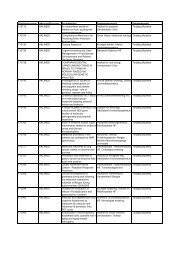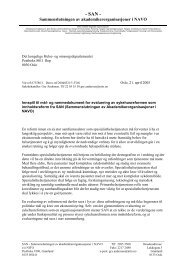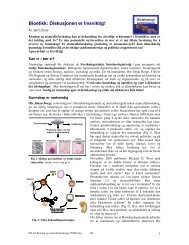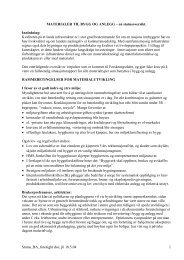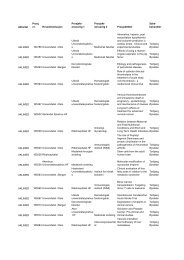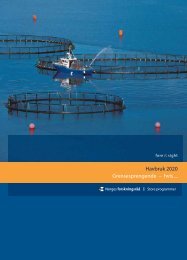A Revolution in R&D
A Revolution in R&D
A Revolution in R&D
You also want an ePaper? Increase the reach of your titles
YUMPU automatically turns print PDFs into web optimized ePapers that Google loves.
50<br />
tions, <strong>in</strong>terfaces, and so on. The necessary work can<br />
be divided <strong>in</strong>to three broad areas:<br />
•Rebalanc<strong>in</strong>g the value cha<strong>in</strong><br />
• Establish<strong>in</strong>g the new organization and its<br />
governance<br />
• Manag<strong>in</strong>g organizational change<br />
Rebalanc<strong>in</strong>g the Value Cha<strong>in</strong><br />
The old ways of conduct<strong>in</strong>g R&D are often unsuited<br />
to the new era. As the first chapter showed, the traditional<br />
R&D value cha<strong>in</strong> no longer works. For one<br />
th<strong>in</strong>g, its smooth flow quickly becomes disrupted by<br />
a series of bottlenecks, <strong>in</strong>duced by the different<br />
productivity ga<strong>in</strong>s at different phases. For another,<br />
its sequence is unsusta<strong>in</strong>able, s<strong>in</strong>ce the new technologies<br />
dance to a different schedule: much of the<br />
chemistry phase might now take place simultaneously<br />
with target validation, for example. To re<strong>in</strong>state<br />
a smooth flow (while enjoy<strong>in</strong>g the new, much<br />
accelerated rate of throughput), R&D needs to ease<br />
the bottlenecks and adjust to a reconfigured value<br />
cha<strong>in</strong>. And that means redistribut<strong>in</strong>g resources<br />
and, more importantly, redesign<strong>in</strong>g processes, as<br />
well as keep<strong>in</strong>g the new value cha<strong>in</strong> <strong>in</strong> balance.<br />
Restor<strong>in</strong>g Balance: Reallocation versus Redesign<br />
At first sight, the bottleneck problem would seem<br />
fairly simple to resolve: scale up downstream steps<br />
to meet the <strong>in</strong>creased demand. But how feasible<br />
would that be? The number of targets identified<br />
could <strong>in</strong>crease sixfold or more. To scale up to meet<br />
that <strong>in</strong>crease, a company accustomed to spend<strong>in</strong>g<br />
$1 billion on all of R&D would now have to spend<br />
more than $1.5 billion on target validation alone.<br />
Another simple approach suggests itself: adjust<br />
resources along the value cha<strong>in</strong> <strong>in</strong> order to br<strong>in</strong>g<br />
the uneven phases back <strong>in</strong>to balance, shift<strong>in</strong>g funds<br />
from more efficient phases (notably target discovery)<br />
to less efficient downstream phases (such as<br />
precl<strong>in</strong>ical). But such reallocation of resources is,<br />
on its own, an overcautious measure, and will not<br />
have a really dramatic impact on R&D economics. It<br />
neglects, or even distracts from, the central opportunity<br />
that genomics offers: the opportunity to<br />
“raise the game” by chang<strong>in</strong>g fundamentally the<br />
way R&D is conducted.<br />
This transformation of R&D will derive above all<br />
from the bold reconfigur<strong>in</strong>g of processes, for the<br />
sake of both physical process flow and <strong>in</strong>formation<br />
flow. For the former, new technology platforms<br />
need to be <strong>in</strong>tegrated and optimized, both with<strong>in</strong><br />
value cha<strong>in</strong> steps and across the value cha<strong>in</strong>. (In<br />
some cases, this may require a discipl<strong>in</strong>e and a<br />
rearrangement comparable to the mov<strong>in</strong>g assembly<br />
l<strong>in</strong>e <strong>in</strong>troduced by Henry Ford <strong>in</strong> 1913.) As for<br />
<strong>in</strong>formation flow, the tremendous amount of data<br />
generated by the new technologies rema<strong>in</strong>s worthless<br />
unless translated <strong>in</strong>to functional <strong>in</strong>formation<br />
and supplied punctually—that is, <strong>in</strong> time to <strong>in</strong>fluence<br />
the decisions be<strong>in</strong>g made. (See sidebar,<br />
“Establish<strong>in</strong>g a Unified Informatics Structure.”)<br />
The extent of the redesign, and the particular<br />
shape the new flows take, depend very much on the<br />
company’s strategy choices. Processes that are newly<br />
<strong>in</strong>dustrialized, but that still follow a traditional<br />
R&D sequence, need to be systematized. In some<br />
cases, however, the traditional R&D value cha<strong>in</strong> will<br />
need to be disrupted. To <strong>in</strong>tegrate chemical genomics<br />
and genetics, for <strong>in</strong>stance, would necessitate a<br />
major restructur<strong>in</strong>g of the value cha<strong>in</strong>. Chemical<br />
genomics <strong>in</strong>troduces a new parallelism, as target<br />
validation and chemistry activities are conducted<br />
simultaneously; the two processes now <strong>in</strong>teract<br />
rather than just <strong>in</strong>terface. And genetics <strong>in</strong>troduces<br />
feedback loops, where late-phase f<strong>in</strong>d<strong>in</strong>gs (such as<br />
genetic <strong>in</strong>formation from the cl<strong>in</strong>ic) feed back <strong>in</strong>to<br />
earlier steps of the value cha<strong>in</strong> (such as diseasegenetics-based<br />
target discovery).<br />
In anticipation of any process redesign, <strong>in</strong>dividual<br />
function heads should be ponder<strong>in</strong>g the cont<strong>in</strong>gencies:<br />
how and when genomics might affect<br />
them, and what actions to take when it does. As one<br />
bottleneck is relieved, another is created: When will<br />
the bottleneck reach their step <strong>in</strong> the cha<strong>in</strong>, and<br />
what will its impact be? What new technologies and



